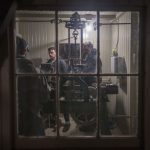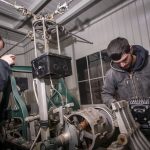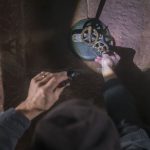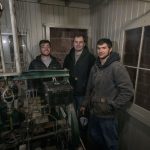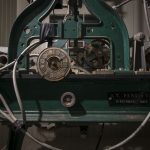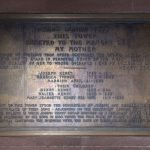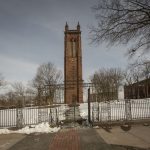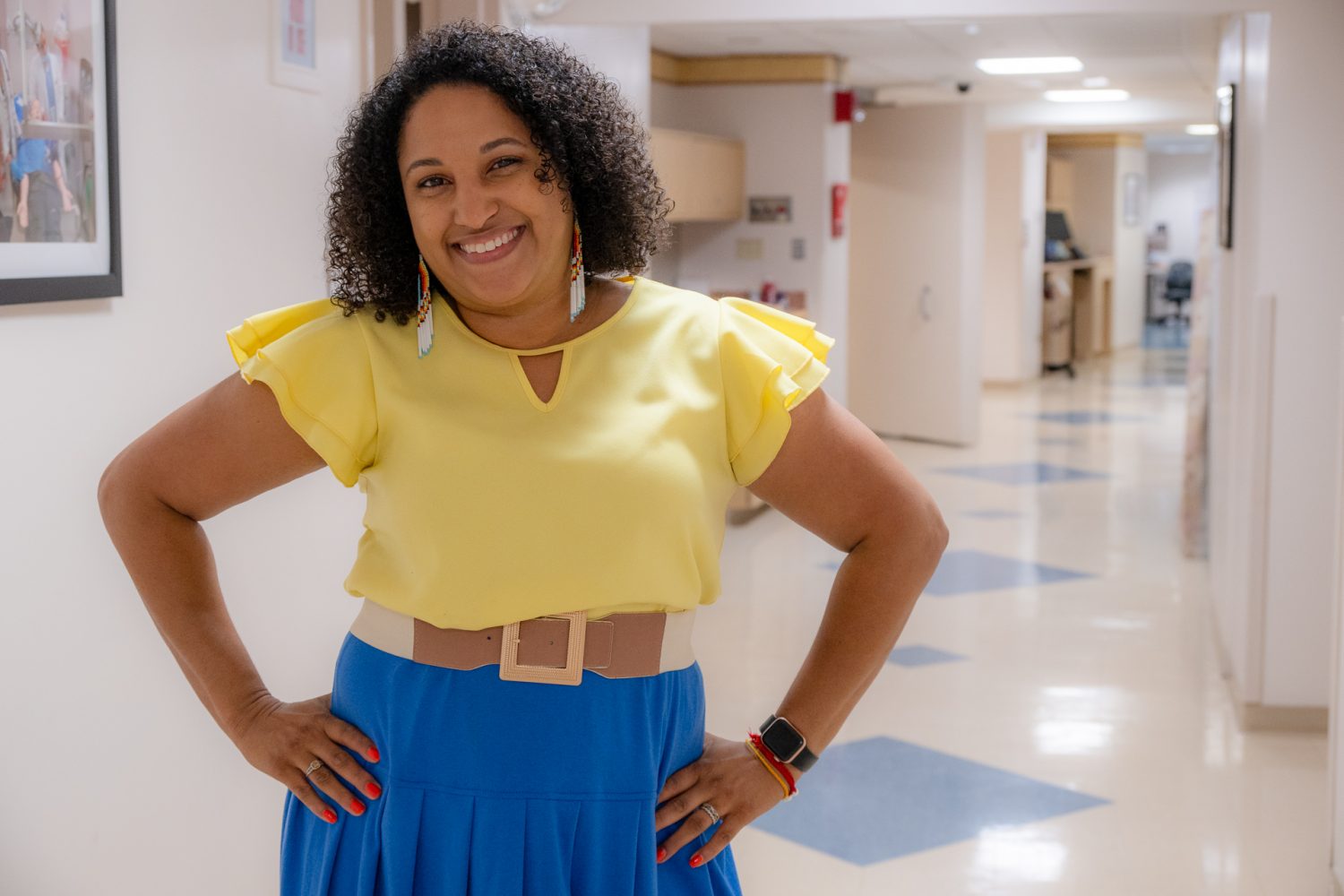The 130-foot-tall Keney Memorial Clock Tower sat silent and immobile for a number of years, the hands on its four clock faces no longer turning and its bells no longer sounding the hours from the small park at the intersection of Albany Avenue and Main Street, just north of downtown Hartford.
The historic tower’s original chimes are now ringing again, though, through a partnership with the City of Hartford, the nonprofit Friends of Keney Park and Keney Park Sustainability Project, the UConn Office of Service Learning Initiatives, and the UConn School of Engineering’s Mechanical Engineering Senior Design program.
Constructed in 1898 in Gothic Revival style out of reddish-brown ashlar from a quarry in Longmeadow, Massachusetts, the Keney Tower is said to be the capital city’s only freestanding tower, and it stands as a reminder of brothers Henry and Walter Keney, public-spirited businessmen who died without heirs and left portions of their estate to the city. While the tower underwent major renovations in the early-to-mid nineties, years of disrepair again left the tower quiet.
UConn seniors Henry Courchaine ’19 (ENG), Garrett Murphy ’19 (ENG), and Spencer Padget ’19 (ENG) worked with the city’s administration and the nonprofit groups to get the bells ringing again. Jacob Parent, a student at Quinebaug Valley Community College, also participated in the project in the fall semester of 2018.
“We first saw the clock tower in about mid-September,” said Murphy. “Our first goal when we got the project was total evaluation. There weren’t any up-to-date specs or drawings on it, so we had to go in there and say, ok, what’s missing, what’s not working, what is working. And we found a lot of stuff that wasn’t working.”
That evaluation initially involved both inspection and contemplation – including many hours spent staring at the mechanisms, taking notes, estimating the distance between components, and determining the pieces needed to restore the clock’s operation.
“One of our goals was to try to maintain as much of the existing mechanical components as possible from the original design so it still had that old charm to it, but updating the electronics and fixing and repairing whatever needed to be fixed so that it can run smoothly going forward,” said Courchaine. “This involved a lot of investigation – pulling things apart, seeing what’s wrong, and going from there. There have been a number of modifications to the tower over the years, so we pieced together what we could from different designs.”
Two of the clock’s faces had seized, leaving the hands unable to turn, and the historic chimes and bells had been disconnected. An electric motor – added during the earlier restoration to modernize the original weighted mechanism of the clock – would smoke when fired up, and the control panel showed signs of a short circuit as well. The earlier renovations to the tower had also involved disconnecting the weighted mechanisms that manually operated the chimes, replacing them instead with a computerized speaker system; the students worked to restore operation of the original, historic bells.
“It was definitely a little bit of a scavenger hunt,” Murphy said. “Oh, what’s going on over here? That’s broken. What’s going on over here? That’s broken.”
The students’ advisor, mechanical engineering faculty member Tom Mealy ’08 (ENG), inspected the clock tower last year before Senior Design’s administrators accepted the project for the program. “It’s one of those things, like opening a Pandora’s Box,” he said. “[The students] did a great job.”
No historical plans or schematics existed to guide the students’ efforts; missing linkage arms and other parts needed to be designed from scratch and fabricated out of modern materials to complement the existing 19th-century mechanisms. 3D printing technology allowed the team to design parts on campus in Storrs, and then test fit them at the tower before creating permanent pieces out of metal.
“It’s really breaking it into components,” said Padget. “Once this is spinning, what mechanically needs to happen? Alright, if that’s spinning, what drives it to spin? Alright, and how are we going to control when it spins?”
Senior Design is a hallmark of the School of Engineering’s undergraduate programs. The two-semester course – a graduation requirement – engages students as teams that work to solve real-life engineering problems for mostly industry sponsors. Students learn and experience the importance of schedules, communication, budget constraints, and customer expectations.
Professor Vito Moreno ’73 MS, ’85 Ph.D., who directs the Senior Design program for the Department of Mechanical Engineering, said the Keney Clock Tower was the most sought-after project in this year’s program.
“In our [mechanical engineering] senior class this year we had 178 students, and they all vote on which projects they want to work on,” Moreno said. “This project was the number one project. A third of the class actually wanted to work on this project, so these guys were pretty lucky.”
Added Mealy, “I think they’re going to get an A.”
For the students, the hands-on development of pragmatic solutions to the Keney Tower’s engineering challenges – as well as the community aspect of the project – was a large part of the project’s appeal.
“I like the idea that every time I drive through Hartford, I’ll be able to point at the clock and say, ‘I had a little piece in that,’” said Courchaine.
Project sponsor Henry Hester, vice president of the Friends of Keney Park, said it’s his hope that the clock tower’s restoration will help bring alive the story of Henry Keney and his lasting influence on the city of Hartford.
“It’s all about creating an energy and keeping people awakened to the history, because there’s a lot of history in Hartford,” Hester said. “We can see the passion that Henry Keney had for the city, and see his timeline and what he did for the city, giving us the 693 acre park … Basically, bring it back to life.
“I love the fact that, having UConn on board, you bring youth ingenuity, and I think it can be an awakening for other youth in Hartford who see kids doing this kind of work,” he said.
“The Keney Memorial Clock Tower is an impressive example of the role that an anchor institution like UConn can play when community partnerships are well maintained and the right people at UConn are listening to what the community has to say,” said Julia Yakovich, UConn’s director of service learning initiatives, who brought the project to the Senior Design program. Service learning, she added, “enables faculty and students to activate their coursework into sophisticated problem-solving with and for the community.”
Yakovich said that plans for a second phase of the project – which she hopes will engage UConn landscaping students to revamp the park surrounding the tower and UConn electrical engineering students to explore installing solar panels to power the tower and lighting systems in the park – are currently under discussion.
Listen to Julie Bartucca of UConn 360 podcast speaking with some of the participants in this project:
For full episodes of the UConn 360 podcast, visit uconn.edu/uconn360-podcast.
